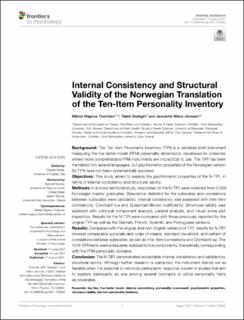| dc.contributor.author | Thørrisen, Mikkel Magnus | |
| dc.contributor.author | Sadeghi, Talieh | |
| dc.contributor.author | Wiers-Jenssen, Jannecke | |
| dc.date.accessioned | 2021-08-19T11:30:29Z | |
| dc.date.available | 2021-08-19T11:30:29Z | |
| dc.date.created | 2021-07-14T22:33:17Z | |
| dc.date.issued | 2021 | |
| dc.identifier.citation | Thørrisen, M. M., Sadeghi, T. & Wiers-Jenssen, J. (2021). Internal consistency and structural validity of the Norwegian translation of the Ten-Item Personality Inventory (N-TIPI). Frontiers in Psychology, 12, 723852. | en_US |
| dc.identifier.issn | 1664-1078 | |
| dc.identifier.uri | https://hdl.handle.net/11250/2770281 | |
| dc.description.abstract | Background: The Ten-Item Personality Inventory (TIPI) is a validated brief instrument measuring the five-factor model (FFM) personality dimensions, developed for instances where more comprehensive FFM instruments are impractical to use. The TIPI has been translated into several languages, but psychometric properties of the Norwegian version (N-TIPI) have not been systematically explored.
Objectives: This study aimed to explore the psychometric properties of the N-TIPI, in terms of internal consistency and structural validity.
Methods: In a cross-sectional study, responses on the N-TIPI were collected from 5,009 Norwegian master graduates. Descriptive statistics for the subscales and correlations between subscales were calculated. Internal consistency was assessed with inter-item correlations, Cronbach’s α and Spearman-Brown coefficients. Structural validity was explored with principal component analysis, parallel analysis, and visual scree plot inspection. Results for the N-TIPI were compared with those previously reported for the original TIPI as well as the German, French, Spanish, and Portuguese versions.
Results: Compared with the original and non-English versions of TIPI, results for N-TIPI showed comparable subscale rank order of means, standard deviations, and pattern of correlations between subscales, as well as inter-item correlations and Cronbach’s α. The 10 N-TIPI items were adequately reduced to five components, theoretically corresponding with the FFM personality domains.
Conclusion: The N-TIPI demonstrated acceptable internal consistency and satisfactory structural validity. Although further research is warranted, the instrument stands out as feasible when it is essential to minimize participants’ response burden in studies that aim to explore personality as one among several concepts or utilize personality traits as covariates. | en_US |
| dc.language.iso | eng | en_US |
| dc.publisher | Frontiers | en_US |
| dc.rights | Navngivelse 4.0 Internasjonal | * |
| dc.rights.uri | http://creativecommons.org/licenses/by/4.0/deed.no | * |
| dc.subject | Big five | en_US |
| dc.subject | Five-factor model | en_US |
| dc.subject | Internal consistency | en_US |
| dc.subject | Personality assessment | en_US |
| dc.subject | Psychometric properties | en_US |
| dc.subject | Structural validity | en_US |
| dc.subject | Ten-item personality inventory | en_US |
| dc.title | Internal consistency and structural validity of the Norwegian translation of the Ten-Item Personality Inventory (N-TIPI) | en_US |
| dc.type | Peer reviewed | en_US |
| dc.type | Journal article | en_US |
| dc.description.version | publishedVersion | en_US |
| dc.source.volume | 12 | en_US |
| dc.source.journal | Frontiers in Psychology | en_US |
| dc.identifier.doi | 10.3389/fpsyg.2021.723852 | |
| dc.identifier.cristin | 1921797 | |
| dc.source.articlenumber | 723852 | en_US |
| cristin.ispublished | true | |
| cristin.fulltext | original | |
| cristin.qualitycode | 1 | |

